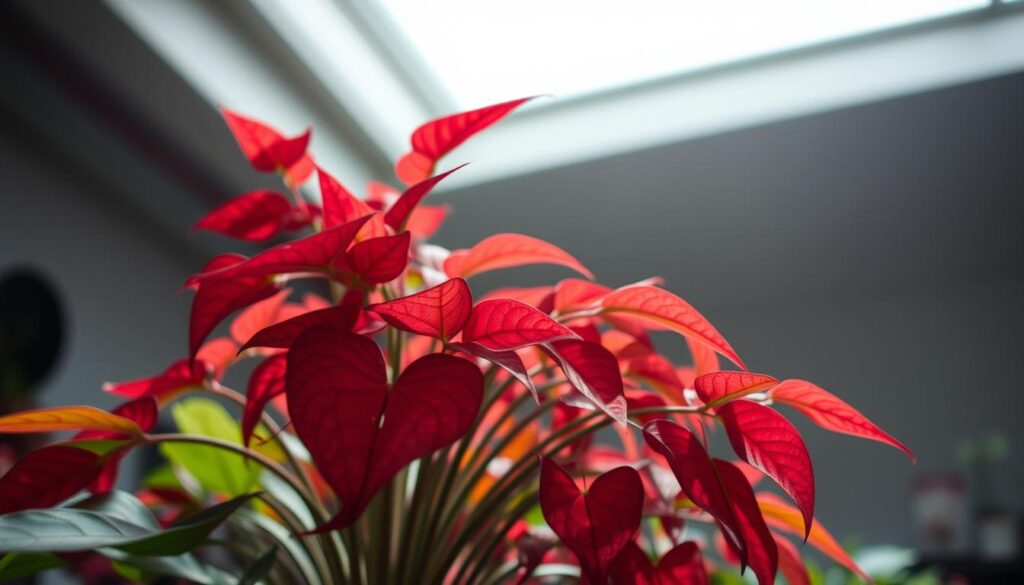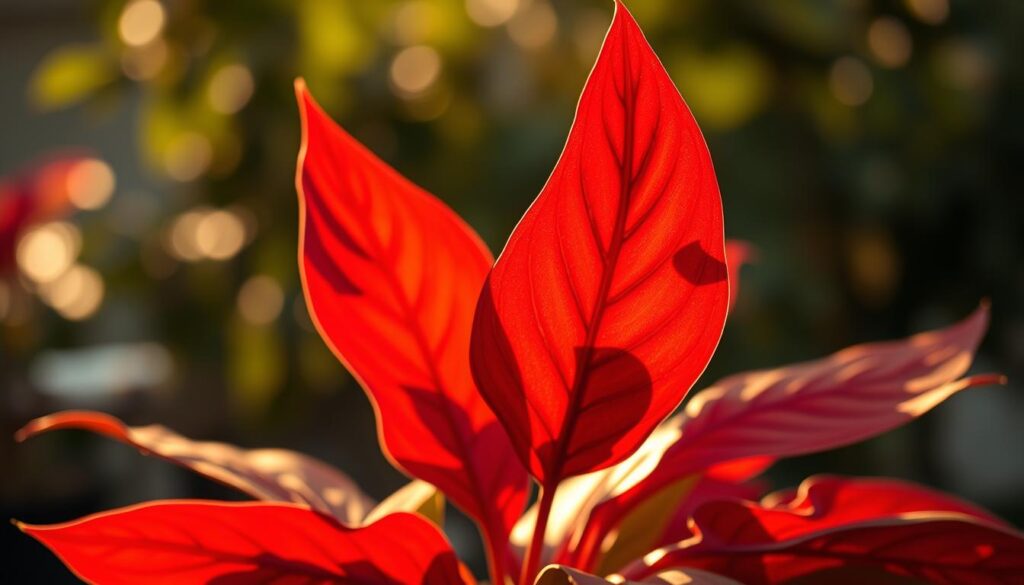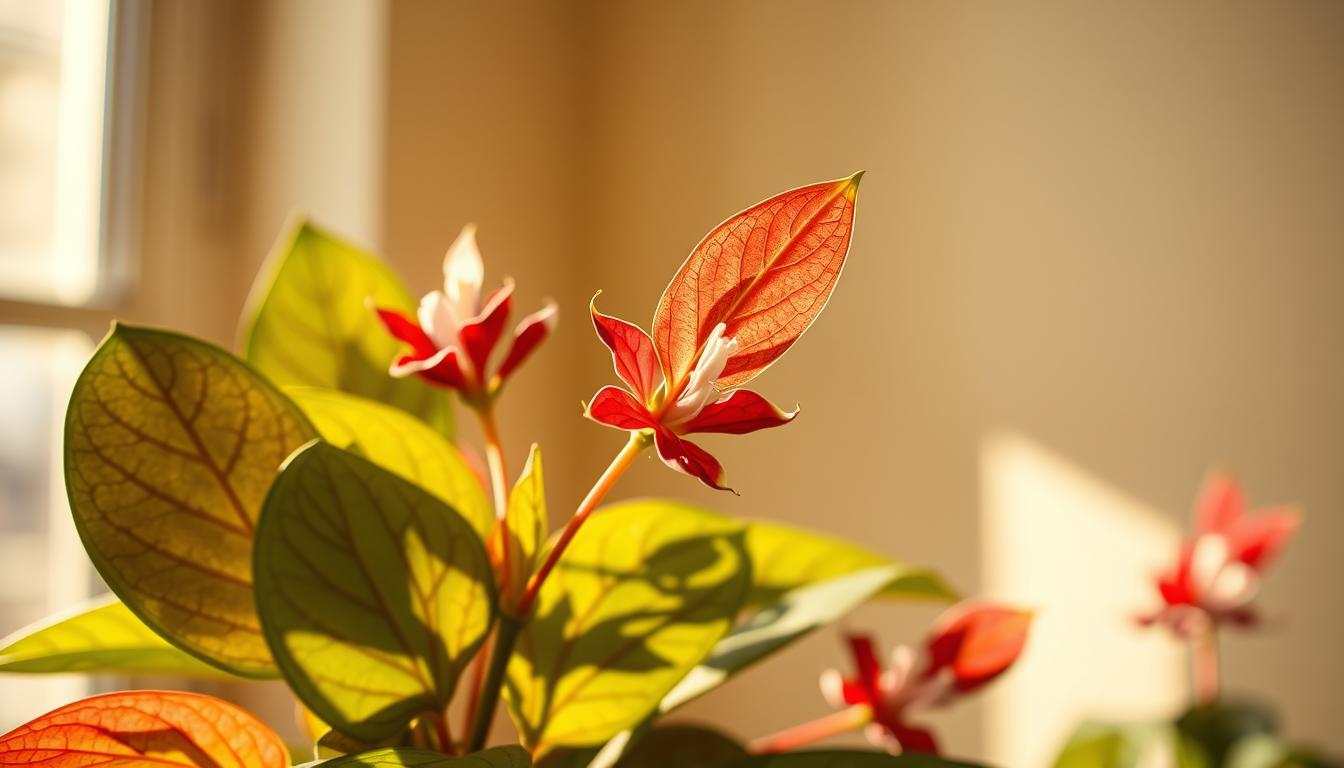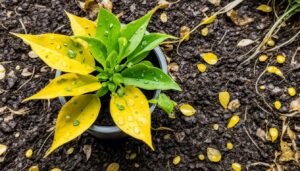Introduction to the Red Butterfly Wing Plant
Exploring exotic plants, you’ll find the Red Butterfly Wing Plant. It loves warm places. To keep it happy, follow red butterfly wing plant care tips and a good red butterfly wing plant watering guide. This will make your plant thrive. The Red Butterfly Wing Plant comes from tropical areas. It’s known for its beautiful leaves and love for humid air. Knowing where it comes from helps you care for it better.Origin and Natural Habitat
The Red Butterfly Wing Plant grows wild in tropical places. It loves humid air and warm weather. This makes it perfect for homes with similar conditions.Unique Characteristics
The plant’s leaves look like a butterfly’s wings. It does well in warm, humid places. With the right red butterfly wing plant care tips, it can reach its best.Why Choose This Plant
The Red Butterfly Wing Plant adds tropical beauty to your home. It’s easy to care for and looks amazing. With a good red butterfly wing plant watering guide, your plant will flourish.Essential Red Butterfly Wing Plant Care Requirements
To keep your Red Butterfly Wing plant thriving, it’s crucial to understand its red butterfly wing plant sunlight requirements. This plant loves bright shade or filtered sunlight. It’s perfect for rooms with limited direct sunlight. When it comes to soil requirements for red butterfly wing plant, well-draining soil is key. Keep the soil evenly moist. Adding organic matter to the soil helps with drainage and nutrients. Lighting is a big part of caring for your Red Butterfly Wing plant. It can handle partial shade but needs 6-8 hours of sunlight for best growth. For more flowers, place it where it gets morning sunlight. Here are some more tips: * Use well-draining soil to avoid water pooling and soggy soil * Add organic matter to the soil for better drainage and nutrients * Check the soil pH regularly to keep it in the right range for your plant’s health By following these tips and knowing the red butterfly wing plant sunlight requirements and soil requirements for red butterfly wing plant, you’ll create a great home for your plant.Creating the Perfect Growing Environment
To make your Red Butterfly Wing Plant happy, think about temperature, humidity, and air flow. The right conditions help your plant grow well. Pruning your plant often keeps it looking good and encourages new growth. Most plants like daytime temperatures between 65-75°F (18-24°C) and cooler nights. Humidity should be between 40-60% to avoid moisture problems. Air circulation is key to stop fungal diseases and ensure even growth. Use fans or move the plant to get better air flow. For the best fertilizer for red butterfly wing plant, pick a balanced, water-soluble one. It gives your plant the nutrients it needs to grow. Follow these tips and use the right fertilizer to make your Red Butterfly Wing Plant bloom beautifully. Here are some key factors to consider when creating the perfect growing environment:- Maintain optimal temperature ranges
- Monitor and adjust humidity levels
- Ensure adequate air circulation
- Use a balanced, water-soluble fertilizer
- Prune your plant regularly using red butterfly wing plant pruning techniques
Mastering the Watering Schedule
Understanding red butterfly wing plant care means knowing how to water it right. The Red Butterfly Wing Plant likes soil that drains well and stays moist but not wet. Water it every 3-5 days when it’s growing, and less in winter to avoid root rot. Watch out for common pests for red butterfly wing plants like aphids, spider mites, and whiteflies. Use neem oil and insecticidal soap to keep them away. Also, check your plant often and keep things clean to stop pests. By following these tips, your Red Butterfly Wing Plant will do great. Check the soil moisture by feeling it with your finger. Adjust your watering based on what you find. With the right red butterfly wing plant care, you’ll enjoy its beauty and attract butterflies to your garden.
By following these tips, your Red Butterfly Wing Plant will do great. Check the soil moisture by feeling it with your finger. Adjust your watering based on what you find. With the right red butterfly wing plant care, you’ll enjoy its beauty and attract butterflies to your garden.
Soil and Potting Requirements
To make sure your Red Butterfly Wing Plant does well, you need the right soil and potting setup. Knowing the best soil mix is key when caring for this plant. A good potting mix can cut mold risk by half. You can make one with 40% potting soil, 30% perlite, and 30% organic matter. The soil should be fluffy and have at least 15% perlite or pumice for air. This stops water from staying too long and prevents root rot. Up to 30% of plants can get sick from bad care. Using top brands like FoxFarm and Black Gold can help you get the soil just right. By following these tips, you’ll have a healthy, thriving plant. When picking a pot for your Red Butterfly Wing Plant, choose one a bit bigger than its roots. Make sure it has holes for drainage to avoid soggy soil. Repotting your plant every year or when it grows bigger helps it stay healthy. By following these easy tips, you’ll enjoy the plant’s beautiful leaves and unique look.Light Requirements and Placement
Understanding your Red Butterfly Wing Plant’s light needs is key. It loves bright, indirect sunlight. This makes it perfect for areas with less natural light. Place it less than 6 feet from a south-facing window for the best light. A red butterfly wing plant watering guide must consider light needs. If it’s in direct sunlight, water it more often. But if it’s shadier, water it less. Knowing the red butterfly wing plant sunlight requirements helps with watering. Here are some tips for placing your Red Butterfly Wing Plant:- Choose a spot with bright, indirect sunlight
- Avoid direct sunlight, especially during peak hours
- Keep it at least 6 feet from heat sources
- Watch how it reacts to light and adjust its spot as needed

| Light Requirement | Watering Frequency | Optimal Placement |
|---|---|---|
| Bright, indirect sunlight | Every 9 days (when not in direct sunlight) | Less than 6 feet from a south-facing window |
Fertilization and Nutrition Guide
To keep your Red Butterfly Wing plant healthy, it needs the right nutrients. The best fertilizer for red butterfly wing is a balanced one. It should have a ratio of 10-10-10 or 5-10-10. This type of fertilizer supports leaf growth, root development, and blooming. It’s important to fertilize your plant on a schedule to avoid over-fertilizing. Fertilize your Red Butterfly Wing plant once a month when it’s growing. You can also use time-release fertilizers that last from a month to several months, depending on the weather.Types of Fertilizers
- Organic fertilizers: These are made from natural materials like compost, manure, or fish emulsion.
- Inorganic fertilizers: These are synthetic and often cheaper than organic ones.
- Time-release fertilizers: These slowly release nutrients, giving your plant a steady supply.
Pruning and Maintenance Techniques
As you care for your Red Butterfly Wing plant, learning about pruning and maintenance is key. Understanding your plant’s size and growth helps you prune wisely. Cut just above a leaf node to encourage new growth. Always disinfect pruning tools to prevent disease. Regularly check your plant for stress or disease signs. Wilting or discoloration means it needs help. Use organic pest solutions like neem oil for pests like aphids and spider mites. Proper care keeps your plant healthy and blooming. Important maintenance tasks include: * Deadheading to promote more blooms * Pruning in early spring for new growth * Cutting back the plant by one-third to one-half after blooms * Winter/spring cleanup for new growth By following these tips, your Red Butterfly Wing plant will stay healthy and bloom beautifully for years.Dealing with Common Pests and Diseases
When you care for your red butterfly wing plant, knowing about common pests is key. Regular checks help spot problems early. Look for signs like holes in leaves, or stems that are dying back. Good hygiene and removing infested parts are important. Make sure your plant gets enough water and nutrients. This helps prevent stress, which pests and diseases love. Aphids, whiteflies, and spider mites are pests you might see. Use natural treatments like neem oil or insecticidal soap. Introducing beneficial insects and keeping your garden clean also helps. By following these care tips and watching out for pests, your plant will thrive. Enjoy its stunning flowers for many years.| Pest | Signs of Infestation | Treatment |
|---|---|---|
| Aphids | Curled or distorted leaves, sticky substance on leaves | Neem oil, insecticidal soap |
| Whiteflies | Small, winged insects on leaves, yellowing leaves | Yellow sticky traps, insecticidal soap |
| Spider mites | Fine webbing on leaves, yellowing leaves | Neem oil, insecticidal soap |
Propagation Methods and Tips
There are a few ways to propagate your Red Butterfly Wing plant. It’s key to give it the right red butterfly wing plant care. This includes the perfect temperature and humidity. You can use stem cuttings or division, both effective if done right. For stem cutting, take a 4-6 inch piece with several leaf nodes. Let it dry for a few days before planting in a mix that drains well. Keep the soil moist but not too wet, and warm temperatures help it root. This method is a fun way to learn how to care for red butterfly wing plant. Division is another way to propagate your plant. This means splitting the roots in spring or fall and replanting in well-draining soil. Wait for the top inch of soil to dry before watering again, and don’t fertilize for at least six weeks. With these tips and the right red butterfly wing plant care, you can successfully propagate your plant.Success Rate Factors
To boost your chances of success, make sure your plant is healthy and growing. Don’t propagate when it’s blooming or producing new leaves. With the right how to care for red butterfly wing plant techniques and patience, you’ll have no trouble propagating your plant.Conclusion: Growing Your Red Butterfly Wing Plant Successfully
The red butterfly wing plant (Christia obcordata) is a stunning addition to any room. With the right red butterfly wing plant care tips and watering, you can grow a vibrant plant. It will add tropical beauty to your home. To grow your plant well, provide the best conditions. This includes the right temperature, humidity, air, and sunlight. Keep the watering schedule consistent, use well-draining soil, and fertilize regularly. This will help your plant stay healthy and strong. By following this guide, you can avoid pests and diseases and even share your plant with others. With patience and proper care, your red butterfly wing plant will thrive. It will become a beautiful centerpiece in your home for many years.What is the origin and natural habitat of the Red Butterfly Wing Plant?
The Red Butterfly Wing Plant, also known as Christia Obcordata, comes from Southeast Asia’s tropical areas. It grows well in warm, humid places, often in forest understories.
What are the unique characteristics of the Red Butterfly Wing Plant?
This plant is famous for its stunning, bat-shaped leaves in purplish-red colors. It can reach up to 2 feet tall, adding beauty to any room.
Why is the Red Butterfly Wing Plant a great choice for indoor spaces?
It’s perfect for adding tropical beauty to your home. It loves warm conditions and can grow quite tall, making it a standout in any room.
What are the sunlight and soil requirements for the Red Butterfly Wing Plant?
It needs bright shade or filtered sunlight and soil that drains well. Keep the soil moist but not too wet. It’s easy to care for.
How do I create the perfect growing environment for my Red Butterfly Wing Plant?
To grow it well, maintain the right temperature, humidity, and air flow. Prune it right and use the right fertilizer to help it thrive.
How do I properly water my Red Butterfly Wing Plant?
Watering it right is key. It likes moist, well-draining soil but avoid overwatering to prevent root rot.
What are the ideal soil and potting requirements for the Red Butterfly Wing Plant?
It does best in well-draining soil. Choose the right pot size and repot it correctly to keep it healthy.
How much light does the Red Butterfly Wing Plant need?
It prefers bright shade or filtered sunlight. This makes it great for rooms with little natural light. The right light is essential for its growth.
What type of fertilizer should I use for my Red Butterfly Wing Plant?
Use the right fertilizer and follow a feeding schedule. Watch for signs of nutrient deficiency to keep your plant healthy.
How do I properly prune and maintain my Red Butterfly Wing Plant?
Regular pruning and care are vital. Use the right techniques to control its growth and prevent problems.
How do I deal with common pests and diseases that may affect my Red Butterfly Wing Plant?
Spot and treat pests and diseases quickly. Natural treatments and prevention strategies can keep your plant healthy and strong.
How can I successfully propagate my Red Butterfly Wing Plant?
You can use stem cuttings or division to propagate it. Knowing the success factors can help you grow new plants.





